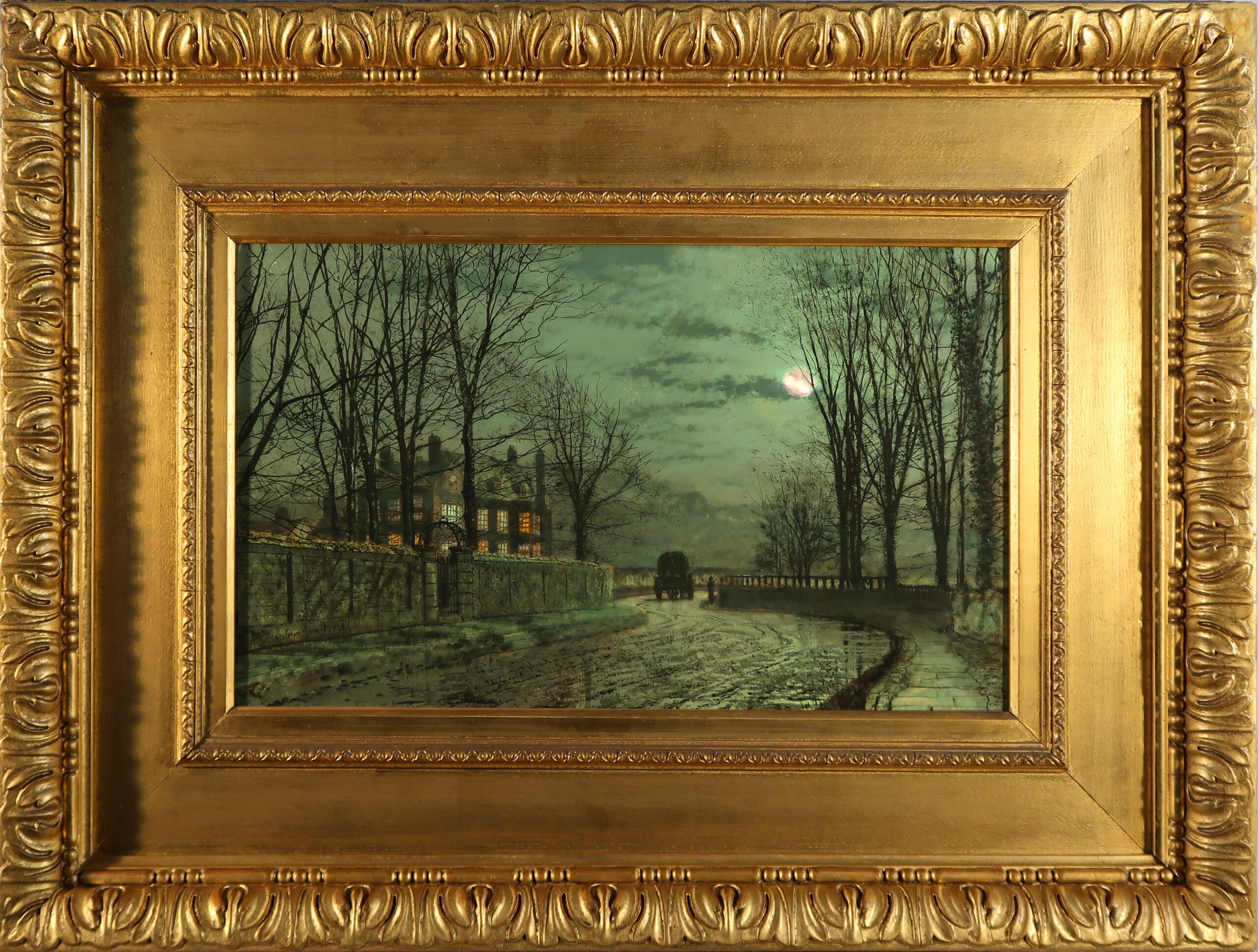A Moonlight Night
Oil on canvas
16 x 22 inches sight size / 20 x 28 inches frame size
Signed
SOLD
A Moonlight Night
Oil on canvas
16 x 22 inches sight size / 20 x 28 inches frame size
Signed
SOLDJohn Atkinson Grimshaw is a remarkable painter who is less widely appreciated than he should be, for many reasons: little is known of his life, he worked mainly in the north of England, most of his paintings are in private collections and he was unfashionably versatile yet he became one of the worlds artist.
John Atkinson Grimshaw first began painting while working as a clerk for the Great Northern Railway. He encountered bitter opposition from his parents, but after his marriage in 1858 to a cousin of T.S. Cooper, he was able to devote himself full time to painting. Self-taught, Grimshaw started exhibiting in Leeds in the 1860’s with minutely observed still life’s. By 1870, he was successful enough to rent a 17th century mansion, following the death of three of his children at his Leeds home. He called it Castle by the Sea, perched on a cliff top, it has magnificent views of both the north and south bays. The name of his Scarborough house came from a poem by Longfellow. The move to the coast inspired much of the artist’s most attractive work, throughout his career he was always attracted by ships, the sea and docks, in fact all things maritime.
Liverpool from Wapping – John Atkinson Grimshaw
Liverpool from Wapping
In the 1870’s he experimented with a looser technique and with classical subjects in the manner of Lawrence Alma-Tadema, historical subjects and contemporary ladies in the manner of Tissot, these last were particularly successful. But the real breakthrough at that time was the night-time scenes the ‘moonlights’ with which he is usually associated today. In the middle of the decade he took a second house in Scarborough, and there are many paintings of seascapes at night. He also traveled to Liverpool and London in search of material and diversified yet again into ‘literary’ subjects. Grimshaw painted mostly for private art patrons, and exhibited only 5 works at the Royal Academy between 1874 and 1886 and one at the Grosvenor Gallery. The towns and docks that he painted most frequently were Glasgow, Liverpool, Leeds, Scarborough, Whitby and London.
Grimshaw’s style and subject matter changed little during his career; he strove constantly to perfect his own very individual vision. He was interested in photography, and sometimes used a camera obscura to project outlines on to oil canvas, enabling him to repeat compositions several times. He also mixed sand and other ingredients with his paint to get the effects he wanted. Although he established no school, Grimshaw’s oil paintings were forged and imitated in his lifetime. Although his moonlit town views are his most popular works, he also painted landscapes, portraits, interiors, fairy pictures and neo-classical subjects.
Park Row, Leeds – John Atkinson Grimshaw
Park Row, Leeds
Around 1880 Grimshaw suffered some unknown financial crisis and retrenched, returning to Leeds and boosting his output to around fifty paintings a year. Certain elements of social realism come into his paintings around that time, night being a good time to record less respectable forms of life. The output of moonlights continued during the 1880’s, particularly of street and dockside scenes, but there were also continuing experiments. He tried painting over photographs, shocking some modern art historians. He tried much less precise, almost naive, paintings, which reflected his friendship with that other nocturnal creature, Whistler, who, in a rare outbreak of generosity, had ceded to Grimshaw priority in the ‘moonlight’ oil painting genre. Grimshaw also tried fairy painting, especially the various versions of Iris which are popular posters today.
During his early period he signed “J.A. Grimshaw” but 1867 dropped the John and signed himself Atkinson Grimshaw. He usually signed his pictures on the front and the back. Two of his sons, Arthur and Louis, were also oil painters. It is difficult to know what this innovative and resourceful painter might have tried next, had he not died of cancer at the age of 57.